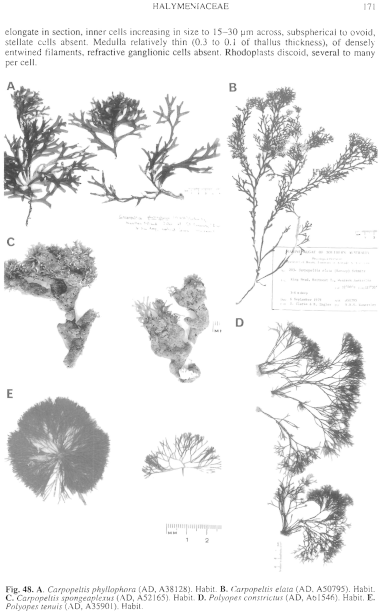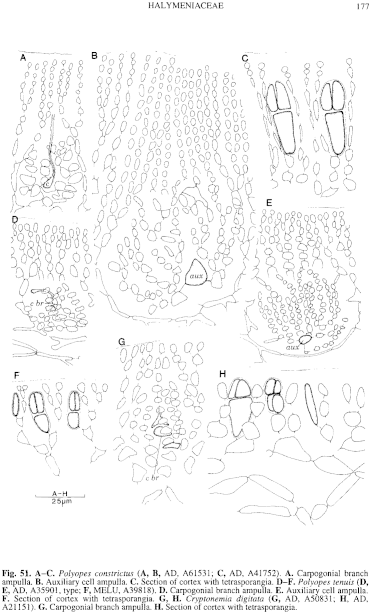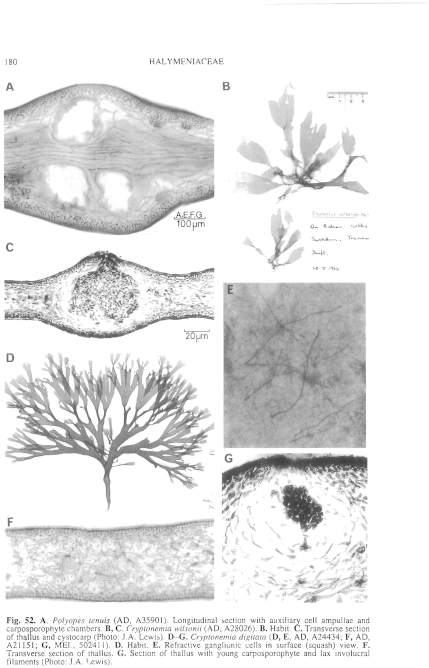|
|
|
|
|
|||||||||||
|
Electronic Flora of South Australia Species Fact Sheet
Phylum Rhodophyta – Class Florideophyceae – Order Gigartinales – Family Halymeniaceae
Thallus (Fig. 48E) dark red-brown, 1–3.5 cm high, cartilaginous, densely tufted with numerous subdichotomous branches. Fronds individually more or less complanately branched, fairly regularly subdichotomous at intervals of 2–5 mm (longer near the base), linear, compressed and (200–) 300–500 µm broad, apices pointed and constricted about fl mm below when fertile. Holdfast discoid, 1–3 mm across; epiphytic on Amphibolis or epilithic. Structure (Fig. 52A) of a firm cortex 80–150 µm thick of anticlinal rows of 5–7 small ovoid cells, dichotomous every 1–2 cells, outer cells 1–2 µm across, inner ones 4–5 µm across, not becoming stellate, and a lax medulla of slender, mainly longitudinal but interlinked filaments 2–4 µm in diameter.
Reproduction: Sexual thalli dioecious. Carpogonial branch ampullae (Fig. 51D) with a few secondary filaments of ovoid cells and a 2-celled carpogonial branch. Auxiliary cell ampullae (Figs 51E, 52A) originating in inner cortex, lying largely in medulla when mature, subspherical and 40–65 µm across with numerous, curved, secondary and tertiary filaments of small subspherical cells, the upper cells sometimes connected to inner cortical cells. Carposporophyte subspherical, (70–) 100–240 µm across, lying in the medulla (Fig. 52A), carposporangia ovoid to angular, 6–8 µm across; involucre loose, moderately conspicuous, several filaments broad, derived from the ampullary filaments which branch further; ostiole small, surrounds often protruding slightly.
Tetrasporangia (Fig. 51F) in slightly swollen terminal nemathecia 0.5–2 mm long and 500–600 µm in diameter, tetrasporangia between cortical cells, basally pit-connected, 15–30 µm long and 6–14 µm in diameter, cruciately divided.
Type from Outer Harbor, S. Aust., drift on Amphibolis (MM-TheM, 6.vi.1970); holotype in AD, A35901; isotype in MELU, A39828.
Selected specimens: Venus Bay, S. Aust., in upper sublittoral reef pools (Womersley, 17.i.1951; AD, A15156). Glenelg, S. Aust., 4.5 m deep on sponge on the "blocks" (Cannon, 4.vi.1987; AD, A57547). Point Lonsdale, Vic., 1–2 m deep (Kraft & La Feria, 13.vii.1990; MELU, A39818). Williamstown, Port Phillip, Vic., 2.5 m deep (Kraft, 26.vii.1990; MELU, A38250). Kingston Beach, Tas., 1–3 m deep (Kraft, 12.v.1976; MELU, A38251). Jervis Bay (just W of Green I.), N.S.W., 8 m deep (Millar & Richards, 7.vi.1990; NSW, A9722).
Distribution: Venus Bay, S. Aust., to Jervis Bay, N.S.W., and SE Tasmania.
Taxonomic notes: P. tenuis is similar in habit, structure and sexual reproduction to other species of Polyopes, differing from P. constrictus in size, much slenderer branches and a laxer medulla, and in tetrasporangial nemathecia surrounding the branch tips. The name reflects the slender habit of the species.
References: The Marine Benthic Flora of Southern Australia Part IIIA
Publication:
Womersley, H.B.S. (14 January, 1994)
The Marine Benthic Flora of Southern Australia
Rhodophyta. Part IIIA, Bangiophyceae and Florideophyceae (to Gigartinales)
Reproduced with permission from The Marine Benthic Flora of Southern Australia Part IIIA 1994, by H.B.S. Womersley. Australian Biological Resources Study, Canberra. Copyright Commonwealth of Australia.
Illustrations in Womersley Part IIIA, 1994: FIGS 48E, 51 D–F, 52A.

Figure 48 enlarge
Fig. 48. A. Carpopeltis phyllophora (AD, A38128). Habit. B. Carpopeltis elata (AD, A50795). Habit. C. Carpopeltis spongeaplexus (AD, A52165). Habit. D. Polyopes constrictus (AD, A61546). Habit. E. Polyopes tenuis (AD, A35901). Habit.

Figure 51 enlarge
Fig. 51. A–C. Polyopes constrictus (A, B, AD, A61531; C, AD, A41752). A. Carpogonial branch ampulla. B. Auxiliary cell ampulla. C. Section of cortex with tetrasporangia. D–F. Polyopes tenuis (D, E, AD, A35901, type; F, MELU, A39818). D. Carpogonial branch ampulla. E. Auxiliary cell ampulla. F. Section of cortex with tetrasporangia. G, H. Cryptonemia digitata (G, AD, A50831; H, AD, A21151). G. Carpogonial branch ampulla. H. Section of cortex with tetrasporangia.

Figure 52 enlarge
Fig. 52. A. Polyopes tenuis (AD, A35901). Longitudinal section with auxiliary cell ampullae and carposporophyte chambers. B, C. Cryptonemia wilsonii (AD, A28026). B. Habit. C. Transverse section of thallus and cystocarp (Photo: J.A. Lewis). D–G. Cryptonemia digitata (D, E, AD, A24434; F, AD, A21151; G, MEL, 502411). D. Habit. E. Refractive ganglionic cells in surface (squash) view. F. Transverse section of thallus. G. Section of thallus with young carposporophyte and lax involucral filaments (Photo: J.A. Lewis).

|
Email Contact: State Herbarium of South Australia |

|